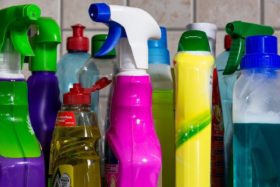
What some think are ordinary daily habits of putting a scented dryer sheet in with a load of laundry, or simply washing their hair with a new scented shampoo, putting on a strongly scented deodorant, followed by a dash of perfume or cologne, are not really ordinary or even normal. In fact, they may be toxic to the person they are going to sit next to at work, at the movie theater, or even a person who walks by at the grocery store, or even to themselves. According to WebMD, fragrance toxicity is on the rise, both in terms of increased use of fragrance, and in those “allergic” to the ingredients. Fragrance toxicity – yeah, it’s a thing, a serious thing.
Most people don’t realize that the actions they take in an effort to smell “good” for the public, actually results in an offensive smell to many. It can also cause painful migraines, dizziness, upset stomach, and many other symptoms in those who have fragrance allergies, or even just sensitivity to fragrance. This is often referred to as Multiple Chemical Sensitivity (MCS). Notice not multiple fragrance sensitivity, but “chemical”, because “fragrance” is almost always a concoction of chemicals. And not from natural sources, but from you guessed it, from synthetic chemicals.

Why More Fragrances?
Like a smoker whose sense of smell is diminished by repeated exposure to the cigarettes they inhale, so is the perfume user who is not even aware they are assaulting their own very sensitive and important sensory system. Our noses are intended to warn us of dangers, so that we don’t eat poison, spoiled food, or things that naturally taste bad like tree bark, or plastic. Noses also warn us of toxic chemicals nearby that could be fatal. The more perfume a person uses, the more s/he feels the need to use, as their sense of smell is diminished, giving the false impression that something is not scented enough. So the person puts on more and more, uses more dryer sheets, stronger shampoo, stronger aftershave, stronger scented candles, stronger strong stronger, more, more, more.
In the COVID-era of mask wearing, the masks initially and temporarily helped a little to filter out these toxic fragrances. However, in the longer term, mask wearing has actually made the problem worse. Since people can’t smell these scents enough with their masks on, what do they do? They use even more of them so they can smell them with their masks on! Brilliant!
All the while no one gives consideration that these very scents intended to please the nose, are caustic, harmful, and may even result in cancer or reproductive harm. (For example, phthalates are frequently used in “fragrances” of all types, and have been undeniably shown to cause reproductive harm.) No one asks the very important questions of where these fragrances come from, how they were made, what other chemicals lurk in them, and what harm they may be causing to all of our health (including the person wearing it).

Worse yet, there is absolutely zero protections for us from any government agencies. Fragrances are legally considered proprietary trade secrets, and do not have to be disclosed. They do not have to be disclosed on personal care product labels, or even on labels of things intended for ingestion.
The more users become desensitized, the more and more they think they need, so the companies meet that demand with more and stronger formulations. So the cycle is continued once more, only worse. And no one knows the wiser, because no one is paying attention, and few people outside of the fragrance profiteers are informed about the risk.
Why more headaches?
While most people are completely unaware of the toxic perfume aura they are spreading forcefully on the rest of us (not unlike second hand tobacco smoke), the ones who suffer from MCS are the ones who pay. In the WebMD article I referenced earlier, there is no discussion on what can be done about it, no real answers given. Just how to avoid the fragrances if you’re one of the people who suffer from this issue.
One major issue here is that “fragrance” itself can be one of over 4000 different chemicals, individually or in combination with others. So to pinpoint what a person who is affected by “fragrance” is actually allergic or sensitive to is nearly impossible. Avoidance is the most effective action one can take to protect themselves. But it’s not possible to avoid fragrances in public places or the workplace. Here are a few real world examples.
The other day I had an appointment to establish care with a new doctor, and after waiting a couple weeks for my appointment, I showed up a half hour early to complete any needed paperwork. When I walked in, the stench (yeah, the heavy perfume in the air was not pleasant at all – at least not to me) was so strong that at first I thought someone wearing heavy perfume must have just passed through. But after 30 minutes, the smell just kept getting stronger. I finally asked if the perfume was always this heavy in their office. The poor receptionist, who was clearly not well, simply replied “usually just on Friday’s, when the massage therapist is here, it’s her massage oils. I know it’s strong, but there’s nothing we can do about it. And it gives me an awful headache every time.”

It gives her a headache? While I felt bad for the receptionist, I also felt bad for myself. Such prolonged exposure meant I was sure to have a migraine in just a couple hours, and the longer I stayed there, the longer my migraine would last. I politely let the receptionist know I would be waiting outside.
But that was no better. That stench was so strong that I continued to smell it, even standing outside.

I considered my options. If I stay, another room might not be so strong, and it could be bearable, but at what risk to me? If I stay, I might also have to endure this on a regular basis each time I need to come for an appointment. But if I leave, I may be charged for the appointment without receiving any actual care.
I decided to smell how bad the rest of the building was and went back inside to ask for the location of the restroom. But the stench was equally bad everywhere. I went back to the receptionist and told her I must leave, but I do not want to be charged for the appointment, as I was having an allergic reaction to their “ambiance.” The receptionist (who clearly had a headache) was understanding, and likely even jealous that I had the option to leave. She did not, if she wanted to put food on her table.
Even when I opted to buy my groceries online, where I only had to drive to the designated pick up parking space at my local grocery store, I was still assaulted by fragrances from the grocery clerk who put the bags of groceries in my car. She claimed she wasn’t wearing any perfume, “just lotion” she said. (Because fragrance when in lotion is somehow no longer fragrance?)
Or when the receptionist at the doctor’s office mailed me some instructions, the contents of the envelope were covered with whatever stench the receptionist used as a lotion on her hands. I could hardly hold and read the letter, let alone wash off the stench from my hands after handling the letter.
Or when a former boss put me in an isolated office, and chose to stand 10 feet away when she had to talk to me, as if the perfume would stop at some invisible barrier. It’s like having a peeing section in a public swimming pool. While her intentions were good (she really tried), and I heard many whispers from others about how her heavy perfume use bothered them as well, I was still the only one who spoke up.
And that’s just it. People who have these allergies/sensitives are not standing up for themselves enough. They are not telling the grocery bagger that their smell is offensive to them. They are not telling the little old lady sitting next to them at the opera house that her olfactory cells are fooling her into thinking she’s not wearing enough perfume, both due to her age and due to overuse of fragrances. And people unfortunately tolerate air pollution of their work spaces simply because they need a job.
Then there are those who wear fragrances and force others to breathe them in. These people who wear these chemicals are not open minded to even consider that how they smell may not just disgust someone else, but go so far as to cause themselves and others harm. I know this. I know this because when I confront people to tell them they’re wearing too much perfume, they just say “no I’m not”, as if denying reality will somehow make it true. And when I tell my “friends” that I would like them to please skip the perfume and other scented products if they want me to join them for the evening, they innocently say “I didn’t realize that dryer sheets were included in this” (or something like that). Which is the same excuse they used last time.

You are Also Harming Yourself, Not Just Strangers
A little synthetic terpenoid in your cologne or aftershave? How about some formaldehyde in your lotion? Maybe a little 1,4-dioxane in your laundry detergent? Phthalates in your perfume? Oh? You say don’t find those in the ingredients list? Are you sure?
There is no law in the US that requires disclosure of all chemical ingredients found in fragrances. None, nothing, nada. That means that companies can include a toxic concoction of any combination of toxic chemicals and simply list on the label “fragrance.”
In one study of household products, 58 out of 59 emitted Volatile Organic Compounds (VOCs), and a total of 72 compounds were found. These compounds included limonene (44.2%), acetone (18.6%), α-pinene (18.6%), o,m,p-xylenes (18.6%), decane (17.0%), toluene (17.0%), β-myrcene (11.9%), ammonia (10.2%), ethylbenzene (10.2%), and hexane (10.2%).1 Ki-Dong Kwon, Wan-Kuen Jo, Ho-Jin Lim, Woo-Sik Jeong. “Characterization of emissions composition for selected household products available in Korea” Journal of Hazardous Materials. Volume 148, Issues 1–2, 5 September 2007, Pages 192-198. https://www.sciencedirect.com/science/article/abs/pii/S0304389407002476
Another study found high levels of VOCs and formaldehyde in 32 consumer products, including air fresheners, glass cleaners, furniture polishes, toilet products, carpet and floor cleaning products. Some of the airborne chemicals discovered are toxic airborne contaminants.2 Cécilia Solal, Christophe Rousselle, Corinne Mandin, Jacques Manel, François Maupetit. “VOCs and formaldehyde emissions from cleaning products and air fresheners.” 11 International Conference on Indoor Air Quality and Climate (Indoor Air 2008), Aug 2008, Copenhague, Denmark. https://hal-ineris.archives-ouvertes.fr/ineris-00973310/
In both of the above studies it is not clear that any of the VOCs that were discovered were listed on any of the product labels.
Perfumes and air fresheners can include VOCs such as terpenes like limonene, alpha-pinene, and beta-pinene; terpenoids such as linalool and alpha-terpineol; ethanol, esters, aldehydes including formaldehyde, benzene, toluene, xylene, and semi-volatile organic compounds, such as phthalates.

Air fresheners can contribute to human exposure to primary and secondary air pollutants. Air freshener exposures, even at low levels, have been associated with a range of adverse health effects, which include migraine headaches, asthma attacks, respiratory difficulties, mucosal symptoms, dermatitis, and neurological problems.3 Sanghwa Kim, Seong-Ho Hong, Choon-Keun Bong, Myung-Haing Cho. “Characterization of air freshener emission: the potential health effects.” The Journal of Toxicological Sciences. 2015. 40-5 p. 535-550. https://www.ncbi.nlm.nih.gov/pubmed/26354370 or https://pdfs.semanticscholar.org/8396/19a733d111f8ce3292bc9d78bd9c7dbea802.pdf
Incidentally, I found this quote from the above study to be rather amusing: “The term ‘air freshener’ may be misunderstood since these products do not considerably reduce air pollutants, but rather add more substances to the air that have an odor strong enough to mask bad odors.” Maybe we should all start using a lot more HEPA air filters instead?
Indoor air pollution from such products has not only been found to cause a number of health conditions, but has also been found to lower people’s sense of well being, and even their work performance.4 Peder Wolkoff. Indoor air pollutants in office environments: Assessment of comfort, health, and performance.” International Journal of Hygiene and Environmental Health. Volume 216, Issue 4, July 2013, Pages 371-394. https://www.ncbi.nlm.nih.gov/pubmed/22954455 So note to management everywhere: fragrance free environments can actually make your staff more productive.
Studies show that up to 34.7% of the general US population report health problems when exposed to products containing fragrance such as air fresheners, laundry, cleaning, and personal care products, along with household items. The health problems reported include among others, respiratory issues, migraine headaches, asthma, mucosal symptoms, rashes of the skin, and neurological problems.5
But when looking at vulnerable sub-popultaions, such as those who are diagnosed with autism and of those with chemical sensitivity, 78.58% and 81.3% respectively, have reported adverse health effects when exposed to fragranced products.5
Maybe you’re not one of the 34.7%, but your children could be, your spouse could be, your best friend could be, or your co-worker might be. Or maybe you have a child who gets frequent headaches and no one has figured out why. Have you tried eliminating fragrances to see if that’s the culprit?

And what about more serious issues such as endocrine disruption and cancer? Just because you don’t get a headache from fragrances doesn’t mean you’re not at risk from the self absorbed exposure.
Many of these exposures do not manifest into disease for many years, so the relationship might not be immediately obvious. But when you have products that include things such as terpene, xylene, aldehydes, esters, and who knows what else, these “constituents can react with ozone to produce secondary pollutants such as formaldehyde, secondary organic aerosol, oxidative products, and ultrafine particles. These pollutants then adversely affect human health, in many ways such as damage to the central nervous system, alteration of hormone levels, etc.”5
Lawsuits Against the New Secondhand “Smoke”
Perhaps an individual basis is not the way to go. Perhaps a bigger picture is needed. Lawsuits have already been won for MCS. The idea of lawsuits continues to be brought up by those with the condition, and those who know what these chemicals can do to the brain.
One former police clerk who filed a lawsuit against her former employer for failure to accommodate her disability by not providing a fragrance free work environment, received a $510,000 settlement. But sadly, they only settled “to avoid the time and expense of trial and to avoid further expenditures in the city’s defense,” not because this is a huge problem in our society that needs to be addressed.
In one case from 2010, a judge ruled that “breathing qualifies as a major life activity” resulting in a $100k settlement for that worker who filed suit. The better news is that the lawsuit caused the employer to post signs asking employees to refrain from wearing scented products. Now that is the kind of win I’m excited about.
A Caltrans employee won $3 million dollars, when all the company had to do was stop using Windex and Comet. But instead they turned his work environment into a hostile work environment because “people just did not like him infringing on their personal right to wear perfume and have smelly objects in the workplace.” What a shame. These people went so far as to sabotage his workplace with perfumes. To the people who don’t care about the air surrounding them that others have no choice but to breathe in – shame on you. How do you like it when a smoker blows smoke in your face? This really is is no different.
Perfumers also beware, because people vote with their wallets and with their lawsuits. That smelly environment you like so much could become VERY expensive.
When you start to see information about employers who refuse to address requests for fragrance free environments to mean that they are violating the Americans with Disabilities Act (ADA), it means that the issue of fragrances and their resulting health effects can no longer be ignored. They especially cannot be ignored by those who are the very users of such products.

You STINK Something Awful
So does your perfume make you stink? Yeah, it does. Your cologne, perfume, dryer sheets, lotion, aftershave, shampoo, conditioner, room spray (air “freshener”), scented candles, all of those things individually or in combination actually smell terrible to some people.
No one will walk into your house and say “oh, it smells bad in here.” They will likely lie to be polite and say “oh, it smells nice in here” when they recognize that you took effort to make your house smell “good” by lighting a scented candle, or spraying some room deodorizer, or putting scented filters in your heater/AC unit.
No one will tell you that your lotion smells like a dilapidated chemical factory that was abandoned 50 years ago.
No one will tell you that sitting next to you is causing them to have blurry vision, or be nauseous, or is giving them a headache or even a migraine.
And no one will tell you that your overuse of perfume is like smoking a cigar right in front of them. Or that it is causing harm to both their health and your health.
And if they did, most people wouldn’t believe them anyway.
But I will tell you. You smell like a migraine headache inviting itself into my head any minute now, with a hint of three days recovery time, and maybe some cancer in the long term.
For Health,
Tober

Nature's Complement is a participant in the Amazon Services LLC Associates Program, an affiliate advertising program. If you purchase products on Amazon through any of our affiliate links, we get a small percentage of the transaction, at no extra cost to you. We spend a lot of time writing the articles on this site, and all this information is provided free of charge. When you use our affiliate links, you support the writing you enjoy without necessarily buying our products. (However we would appreciate if you would do that too!) Thank you for helping to support our work, however you choose to do so.
These statements have not been evaluated by the Food and Drug Administration. This information and/or products are not intended to diagnose, treat, cure or prevent any disease.
References
| ↑1 | Ki-Dong Kwon, Wan-Kuen Jo, Ho-Jin Lim, Woo-Sik Jeong. “Characterization of emissions composition for selected household products available in Korea” Journal of Hazardous Materials. Volume 148, Issues 1–2, 5 September 2007, Pages 192-198. https://www.sciencedirect.com/science/article/abs/pii/S0304389407002476 |
|---|---|
| ↑2 | Cécilia Solal, Christophe Rousselle, Corinne Mandin, Jacques Manel, François Maupetit. “VOCs and formaldehyde emissions from cleaning products and air fresheners.” 11 International Conference on Indoor Air Quality and Climate (Indoor Air 2008), Aug 2008, Copenhague, Denmark. https://hal-ineris.archives-ouvertes.fr/ineris-00973310/ |
| ↑3 | Sanghwa Kim, Seong-Ho Hong, Choon-Keun Bong, Myung-Haing Cho. “Characterization of air freshener emission: the potential health effects.” The Journal of Toxicological Sciences. 2015. 40-5 p. 535-550. https://www.ncbi.nlm.nih.gov/pubmed/26354370 or https://pdfs.semanticscholar.org/8396/19a733d111f8ce3292bc9d78bd9c7dbea802.pdf |
| ↑4 | Peder Wolkoff. Indoor air pollutants in office environments: Assessment of comfort, health, and performance.” International Journal of Hygiene and Environmental Health. Volume 216, Issue 4, July 2013, Pages 371-394. https://www.ncbi.nlm.nih.gov/pubmed/22954455 |
| ↑5 | Uchimura, & Rabin, R. C. (2019, October 29). Volatile chemical emissions from 134 common consumer products. Retrieved from https://medworm.com/739065325/volatile-chemical-emissions-from-134-common-consumer-products/ |


